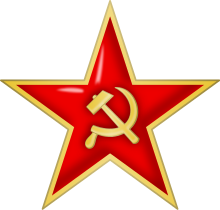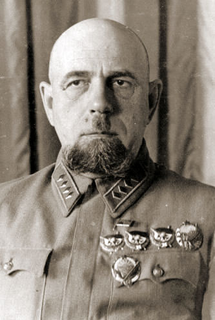
Pavel Efimovich Dybenko, was a Bolshevik revolutionary and a leading Soviet officer and military commander.
Viktor Fedorovich Belash was the Chief of Staff of the Revolutionary Insurrectionary Army of Ukraine (RIAU) under Nestor Makhno. He was of Ukrainian ethnicity. Belash's Memoirs are an important source for the history of this insurrection.
The 52nd Rifle Division was an infantry division of the Red Army during the Russian Civil War, the interwar period, World War II, and the Cold War, formed once during the Russian Civil War and three times during the existence of the Soviet Union.
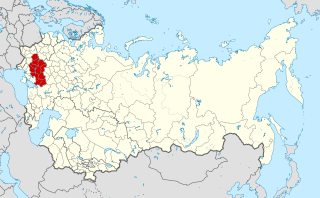
The Kiev Military District was a military district of the Imperial Russian Army and subsequently of the Red Army and Soviet Armed Forces. It was first formed in 1862, and was headquartered in Kiev (Kyiv) for most of its existence.
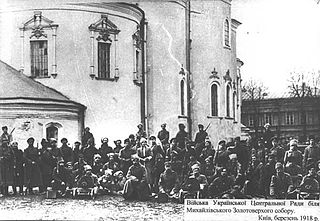
The Soviet–Ukrainian War is the term commonly used in post-Soviet Ukraine for the events taking place between 1917–21, nowadays regarded essentially as a war between the Ukrainian People's Republic and the Bolsheviks. The war ensued soon after the October Revolution when Lenin dispatched the Antonov's expeditionary group to Ukraine and Southern Russia.

South Russia or South of Russia was a short-lived state that existed in Eastern Europe during the Southern Front of the Russian Civil War from 1919 to 1920.
The 51st Rifle Division was an infantry division of the Soviet Army, formed twice. Its first formation was formed during the Russian Civil War and fought in the Perekop-Chongar Offensive in 1920. It also fought in the Soviet invasion of Poland, Winter War and World War II. During World War II, it fought in the Battle of Rostov, Barvinkove-Losowaja Operation and Second Battle of Kharkov before being destroyed at the Battle of Voronezh. Officially disbanded on 28 November 1942, the division was reformed on 15 April 1943 from the 15th Rifle Brigade. The 2nd formation fought in Operation Bagration and the Battle of Königsberg. It appears to have been disbanded in 1946.
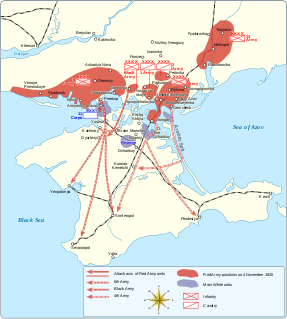
The siege of Perekop, also known as the Perekop-Chongar Operation, was the final battle of the Southern Front in the Russian Civil War from 7 to 17 November 1920. The White Army stronghold on the Crimean Peninsula was protected by the Chongar fortification system along the strategic Perekop Isthmus and the Syvash, from which the Crimean Corps under General Yakov Slashchov repelled several Red Army invasion attempts in early 1920. The Red Army in South Russia and the Black Army, under the command of Mikhail Frunze, launched an offensive on Crimea with an invasion force four-times larger than the defenders, the Army of Wrangel under the command of General Pyotr Wrangel. Despite suffering heavy losses, the Reds broke through the fortifications, and the Whites were forced into retreat southwards. Following their defeat at the siege of Perekop, the Whites evacuated from the Crimea, dissolving the Army of Wrangel and ending the Southern Front in Bolshevik victory.

Prokofy Logvinovich Romanenko was a Ukrainian Soviet Army colonel general.
The 13th Army was a field army of the Red Army during the Russian Civil War, which existed between 5 March 1919 and 12 November 1920.

The Southern Front was a front of the Red Army during the Russian Civil War, formed twice.

The 14th Army was a field army of the Red Army during the Russian Civil War era.
The 3rd Ukrainian Soviet was a field army of the Red Army during the Russian Civil War, which existed between April 15, 1919 and June 13, 1919 as part of the Ukrainian Front. Then the troops became part of the newly formed 12th Army of the Western Front.
The Crimean Soviet Army was a field army of the Red Army during the Russian Civil War, which existed between May 5, 1919 and July 21, 1919. It was first part of the Ukrainian Front and from June 4 of the 14th Army. On July 21, 1919 the Army was disbanded, and it was reorganised as the Crimean Rifle Division, called 58th Rifle Division from July 27.
The Offensive of the Ukrainian Front was a major offensive of the Soviet troops of the Ukrainian Front against the Army of the Ukrainian People's Republic during the Ukrainian–Soviet War, in the context of the Russian Civil War.

The Battle for the Donbas was a military campaign of the Russian Civil War that lasted from January to May 1919, in which White forces repulsed attacks of the Red Army on the Don Host Oblast and occupied the Donbas region after heavy fighting.

The Northern Taurida operation was a military campaign of the Russian Civil War between the Red Army and the Wrangel Russian Army for the possession of Northern Taurida. The campaign can be divided into 3 stages: the White offensive, trench warfare around the Kakhovka Brigdehead and the counterattack of the Red Army.
The 9th Greek Regiment was a regiment that was part of the 3rd Infantry Brigade of the 1st Zadneprovskaya Ukrainian Soviet Division, formed on the basis of the Greek detachments of the Revolutionary Insurgent Army of Ukraine in February 1919.

The 7th Ukrainian Soviet Division was a military unit of the Red Army during the Russian Civil War in the armed forces of the Ukrainian SSR.
The 1st Zadneprovskaya Ukrainian Soviet Division was a military unit of the Ukrainian Soviet Army during the Russian Civil War.
